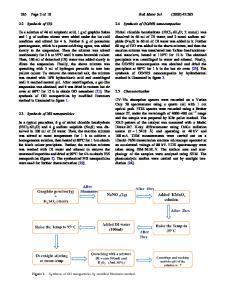Using New Porous Nanocomposites for Photocatalytic Water Decontamination
- PDF / 65,144 Bytes
- 6 Pages / 612 x 792 pts (letter) Page_size
- 61 Downloads / 273 Views
1145-MM04-36
Using New Porous Nanocomposites for Photocatalytic Water Decontamination Maryam Zarei Chaleshtori1, S. M. Sarif Masud2 and *Geoffrey B. Saupe3; 1 Environmental Science and Engineering, 2Material Science and Engineering, 3Department of Chemistry, University of Texas at El Paso, 500 W. University Ave., El Paso, TX, 79968-0513, U.S.A.
ABSTRACT Heterogeneous catalysts that accelerate the photolytic destruction of organic contaminants in water are a potentially inexpensive and highly effective way to remove both trace-level and saturated harmful compounds from industrial waste streams and drinking water. Porous photocatalytic materials can have the combined qualities of high surface area and relatively large particle sizes, as compared with nanoparticulate catalyst powders like titanium dioxide. The larger particle sizes of the porous materials facilitate catalyst removal from a solution, after purification has taken place. We have synthesized new kinds of photocatalytic porous oxide materials that can be used to purify contaminated water by accelerating the photodegradation of any kind of organic pollutant. The new materials have very large open pore structures that facilitate the diffusion, the surface contact of contaminants, and solvent flow through the catalyst. These qualities enhance surface reactions important to the process. The new catalysts have shown robust physical and chemical properties that make them candidates for real applications in polluted water decontamination. INTRODUCTION Water pollution is one of the most serious environmental problems. When human and other animal wastes, toxic chemicals, metals and oils from farming, industry and human activities enter water systems, then fish, animals, plants and finally humans are all affected. In the world, industry is one of the biggest sources of pollution, accounting for more than half the volume of all water contamination and for the most deadly pollutants [1]. Cost-effective reductions of contaminated waters including organic and inorganic industrial chemicals are a well-known need in the world. Many industrial processes demand large amounts of water, which is released into the environment after use. If the wastewater is polluted with hazardous compounds, decontamination of the water becomes important and necessary, and clean-up expenses become a significant factor for industrial processes. Ordinary methods of decontaminating chemicals in water add considerable costs and delay to a production system [2], [3]. The search for economical ways to remove organic and inorganic contaminants has incited the study and exploration of heterogeneous photocatalyst-assisted oxidation methods, which have been shown to effect full mineralization of organic contaminants. Photocatalysis involving the use of UV light with wide band gap semiconductor metal oxides (such as TiO2) appears to be a promising clean-up alternative for the removal of contaminants. Heterogeneous catalysis uses solid photocatalysts and UV light to produce strong oxidizing conditions, s
Data Loading...











